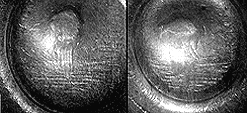In a murder case, one 12 bore fired cartridge case was recovered from the scene of occurrence. The fired cartridge was sent to the laboratory for safe custody, as the involved gun could not be seized. The accused, after committing the crime, evaded interrogation and arrest for a few days. In the mean time, he handed over his licensed gun to an arms dealer for repair. He asked the arms dealer to replace the firing pin, as its protrusion was occasionally ineffective causing misfires. The accused obtained a receipt from the arms dealer. The details of the deposited gun (make serial no. etc.) and the nature of the assigned job were mentioned in the receipt. Thereafter, the accused surrendered himself to the Police and pleaded innocence. He handed over the gun with the changed firing pin to the Police. The said gun was sent to the laboratory for linkage with the questioned fired cartridge. The firing pin marks on the evidence cartridge , as expected, was distinctly different from those available on the test cartridges. However, the breech marks present on the evidence and test cartridges were found to be similar in their individual characteristics. This lead to a definite conclusion that it was the accused gun that fired the evidence cartridge and no other. The defence produced the aforesaid receipt in support of his plea and stressed that the firing pin of the accused gun could not have fired the said evidence cartridge . The expert, during cross examination, produced the photomicrograph ( Fig 1.) which showed dissimilar firing pin marks as well as matching of breech marks on the evidence and test cartridges. As imprinting of breech marks on the evidence cartridge was possible only by the development of pressure, evidently it was the accused gun that fired the questioned cartridge and no other. Therefore, the defence plea was untenable. In addition, deliberate attempt of the accused to destroy the evidentiary clues was taken seriously while convicting the accused.

Fig.1 Dissimilar firingpin and similar breech marks
Keynote:
It is unsafe to form opinion on the basis of dissimilar firing pin marks alone. A negative opinion that the questioned cartridge had not been fired from the suspect firearm can not be inferred unless other marks that are produced by the development of pressure such as breech, chamber, etc. are available and are also dissimilar. In the absence of such marks, one can safely opine only to the extent that the firing pin marks on the questioned cartridge did not tally with the firing pin marks of the suspect firearm.